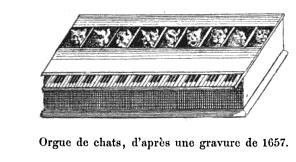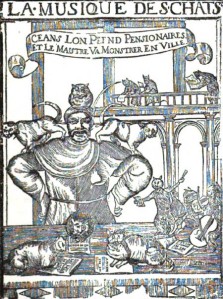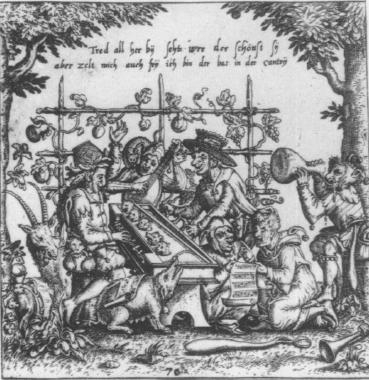Cat Music and Cat Organs February 27, 2011
Author: Beach Combing | in : Modern , trackback**This post is dedicated to the Mad Monk who has supplied Beach with several references over the months and who put Beach onto the precious secret of the Cat Organ.**
Beachcombing has complained before about the strange absence of bizarrism in music and he has never been satisfactorily contradicted. This absence is particularly painful in ‘classical’ music where the composers and musicians involved tend to be too abstracted to do foolish things. However, Beach has recently had his attention drawn to some pleasing nonsense involving cats and music: namely, the cat organ.
Before getting to this diabolical instrument, however: an object capable of sending any animal righter into paroxysms, it should be remembered that the musical range of cats is immense.
So:
‘Dupont de Nemours, a student of animals and their peculiarities, declared that, while the dog only used vowel sounds, the cat in her language made use of at least six consonants, M , N, G, H, V, and F. It seems obvious to me that P, S, and T, may be added as necessary spitting consonants; the H is produced, of course, by the rapid expulsion of breath following this very Magyar explosion of expletives, the cat’s method of cursing. I have never heard a cat use a V, and I would like more information on this point’. (62)
Likewise
Champfleury counted sixty-three notes in the mewing of cats, although he admitted that it took an accurate ear and a great deal of practice to distinguish them. On the other hand we have the testimony of the Abbe Galiani who could only discern twenty notes in the most elaborate mewing, but he found that these constituted a complete vocabulary, as no cat ever uses the same phrase except to express the same sentiment’. (63)
No wonder that Scarlatti stole a fugue from a cat and that Sacchini said that he could only compose when surrounded by the little buggers…
It took humanity, though, until the 1500s (a cruel century, the sixteenth) to harness this potential in Brussels, a corner of the world where Beachcombing has previously suggested bad things happen to good cats. 
At the head marched an enormous bull whose horns were burning, between which there was also a small devil. Behind the bull a young boy sewn into a bear skin ride on a horse whose ears and tail were cut off. Then came the archangel Saint Michael in bright clothing, and carrying a balance in his hand. The most curious was on a chariot that carried the most singular music that can be imagined. It held a bear that played the organ; instead of pipes, there were sixteen [or twenty – accounts differ] cat heads each with its body confined; the tails were sticking out and were held to be played as the strings on a piano, if a key was pressed on the keyboard, the corresponding tail would be pulled hard, and it would produce each time a lamentable meow. (Juan Christoval Calvete)
Philip II of Spain who was in attendance might have been a melancholy old soul, but he collapsed into laughter at the sound. The ‘notes’, Beachcombing suspects were rather less amused. They would become even more impatient when, by the seventeenth century, instead of tail-pulling a sharp point was pressed into their bodies to elicit music (Kircher).
Incredibly the instrument survived. It was to be found at St Germain in 1753 and Prague in 1773. Then, most extraordinarily, it got sucked up into Romantic psychology (Johann Christian Reil, Rhapsodieen über die Anwendung der psychishen Curmethode auf Geisteszerrüttungen(Halle, 1803, p.205) in the early nineteenth century where a patient was to sit before theKatzenclavier. ‘A fugue played on this instrument – when the ill person is so placed that he cannot miss the expression on their faces and the play of these animals – must bring Lot’s wife herself from her fixed state into conscious awareness’ (Richards, ‘Rhaposodies’). Indeed…
Beachcombing dreads to think what the cats got up to when they got out of their little boxes. Renaissance merchants were identifiable by their inky hands, nineteenth-century workers by their calluses: the cat player would doubtless have had long scratches up and down his arms and across his cheeks and, God knows, he deserved it.
Other animal music stories? Beachcombing is begging: drbeachcombing AT yahoo DOT com Beach would also love the Spanish for Calvete if anyone has it. All attempts to track down the original failed.
***
22/Feb 2013 Andy the Mad Monk is expanding his range. He came across the following source about the pig organ. ‘The Abbot of Baigne, a man of great wit, and who had the art of inventing new musical instruments, being in the service of Louis XI, king of France, was ordered by that prince to get him a concert of swine’s voices, thinking it impossible. The abbot was not surprised, but asked for money for the performance, which was immediately delivered him; and he wrought a thing as singular as ever was seen. For out of a great number of hogs, of several ages, which he got together, and placed under a tent or pavillion, covered with velvet, before which he had a table of wood, painted, with a certain number of hogs, he made an organical instrument, and as he played upon the said keys, with little spikes which pricked the hogs he made them cry in such order and consonance, as highly delighted the king and all his company.’ Thanks Andy!
31 Aug 2014: Andy updated with this great video: not particularly informative but hilarious.




